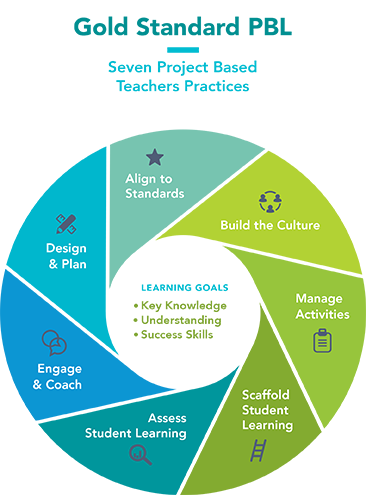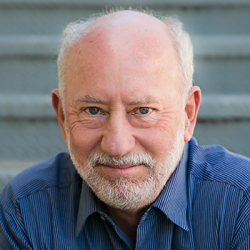I love this story about the role teachers play in PBL, from teacher Elisabeth Bostwick in Horseheads, NY.
"When colleagues have entered my room, at first glance they thought I wasn’t there. I recall the bewildered look of one administrator that I worked for as he scanned the room thinking I had left it unattended. Typically one of the student leaders in my room will notice and point them in my direction. You see, as a coach I’m beside my learners as I question, reflect and provide feedback."
You might have heard about how role of the teacher shifts in PBL...
...from “sage on the stage” to “guide on the side” – but that’s only a catchphrase and it might even be misleading. It doesn’t mean that teachers are never seen in the front of the room during a project, teaching content or building skills through whole-class direct instruction.
That might sometimes be the best way for students to learn a particular thing, even though the goal is to emphasize student independence and inquiry as much as possible. So it’s a balancing act for a teacher, to know when to step back or step up when facilitating a PBL experience.
When we developed our model for Gold Standard PBL in 2015, we focused on how to design a high-quality project. However, our Executive Director at the time and co-author of Setting the Standard for Project Based Learning John Mergendoller made sure we also pointed out the importance of the teacher in PBL.
Some stereotypes of PBL see students working almost entirely on their own on self-chosen projects, with only occasional check-ins with a teacher. That might be appropriate for some projects – say, the high school senior “capstone” project or other research-type projects for students who know how to work independently.
But we’ve found that PBL works best when the teacher plays an active role, so we developed a set of seven Project Based Teaching Practices to help explain it, as shown on the diagram above.
We explore these seven practices in our new book and one of the companion videos.
 The book is co-published with ASCD, due out on Sept. 19, 2018: Project Based Teaching by Suzie Boss, with contributions from me. It will be one of ASCD’s fall Member Books, and will also be available in the Buck Institute’s online store. Along with the book, we’ll be releasing eight new videos, one for each practice plus an extra one for “Build the Culture.”
The book is co-published with ASCD, due out on Sept. 19, 2018: Project Based Teaching by Suzie Boss, with contributions from me. It will be one of ASCD’s fall Member Books, and will also be available in the Buck Institute’s online store. Along with the book, we’ll be releasing eight new videos, one for each practice plus an extra one for “Build the Culture.”
The chapter and video on “Engage and Coach” are based on our rubric for Project Based Teaching, which highlights these key criteria for “Gold Standard” practice for engaging and coaching students:
- The teacher’s knowledge of individual student strengths, interests, backgrounds, and lives is used to engage them in the project and inform instructional decision making.
- Students and teachers use standards to code new goals and benchmarks for the project in developmentally appropriate ways (e.g., by constructing a rubric together).
- Students’ enthusiasm for and sense of ownership of the project is maintained by the shared nature of the work between teachers and students.
- Student questions play the central role in driving the inquiry and product development process; the driving question is actively used to sustain inquiry.
- Appropriately high expectations for the performance of all students are clearly established, shared, and reinforced by teachers and students.
- Individual student needs are identified through close relationships built with the teacher; needs are met not only by the teacher but by students themselves or other students, acting independently.
The video features Suzie and me talking about the practice, with K-12 classroom scenes and the voices of teachers too.
The book has a chapter on Engage & Coach—here’s an excerpt...
Engage and Coach Through the Messy Middle
Many more opportunities to engage and coach emerge as the project unfolds. Like a sports coach, you size up the talents and skills of your “players” and plan learning activities that are just challenging enough to help each improve. You break complicated tasks and ideas into right-sized chunks or steps; scaffold the development of new skills; provide time to practice; and offer constructive, timely feedback. When students make gains or breakthroughs in understanding, you encourage them to reflect on their own growth and set new goals. You celebrate the small wins that will add up to deeper learning.
A coach is also good at reading the temperature of the room. You pay attention to how teams are getting along (or not) and step in when needed to help manage conflict. If students hit roadblocks, you help them learn from failure—and then recover. You know when they need a pep talk and when they need to vent their frustration.
“You can feel fatigue in the middle of a long project,” says Erin Starkey, an instructional coach from Wichita Falls, Texas. If you know your students—a hallmark of a good coach—you’ll be able to read the clues that engagement is flagging. That might be your signal to bring in an outside expert or plan field research to recharge interest in the project.
With elementary students, Starkey uses a project wall to keep artifacts visible. That includes students’ questions. “The board becomes a focal point for students,” she says. “When I know their questions, I can coach better.” Eventually, she says, students start looking at one another’s questions and working together to answer them. “They coach each other.”
Even when students take the lead in designing their own projects, their interest can wane before they reach their goals. Chemistry teacher Ray Ahmed sometimes has to help students overcome a slump in the middle of extended inquiry projects. “It’s exciting for them in the beginning, but after five weeks they might say, ‘I’m tired of this! I’m sick of the question I came up with!’” The teacher coaches them through that challenge by reminding them that scientists often face the same problem. “That’s a real-world issue,” he admits. Successful scientists develop the perseverance to keep going through setbacks.
As you can tell, Suzie Boss has gathered many pearls of wisdom from practicing Project Based Teachers—hope you like the book & videos!
Want to learn more about PBL? Check out our books.

